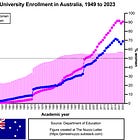Physical Activity by Education Level
Graph of the Week
This week’s graph, courtesy of a report by the National Center for Health Statistics, shows the percentage of adults in the United States (U.S.) in 2022 who met guidelines for both muscle-strengthening and aerobic physical activity by their level of educational attainment.
Key Points
Overall, 22.5% of adults in the U.S. achieved recommended levels for both muscle-strengthening and aerobic physical activity in 2022.
Individuals who had lower educational attainment were less likely to meet recommended guidelines for physical activity.
Approximately 11% of individuals with a high school degree or less met recommended guidelines for physical activity compared to about 34% of individuals who have a bachelor’s degree or higher.
Source: QuickStats: Percentage of Adults Aged ≥25 Years Who Met the 2018 Federal Physical Activity Guidelines for Both Muscle-Strengthening and Aerobic Physical Activity, by Educational Attainment — United States, 2022. MMWR Morb Mortal Wkly Rep 2024;73:521.
Bonus Commentary
Regular participation in both muscle-strengthening activities and aerobic activities is important for living a long and healthy life. Muscle-strengthening activities tend to target the health of the nervous, muscular, and skeletal systems, whereas aerobic activities tend to target the health of the cardiorespiratory system (though these are simplistic generalizations because both types of activities will maintain the health of various organ systems).
The data in the graph show that over three quarters of individuals in the U.S. are not participating in levels of both muscle-strengthening and aerobic activities deemed to be most impactful on health. This is particular true for individuals who have lower education levels. Regularly exercising at the gym or at home are two ways that physical activity guidelines can be met. However, individuals can also work physical activity into their daily routine using some of the following strategies: by walking or cycling to work, taking the stairs rather than the elevator, parking one’s motor vehicle further away from a target destination, or carrying groceries or bags in one’s hands rather than pushing them in a cart.
Related Content at The Nuzzo Letter
SUPPORT THE NUZZO LETTER
If you appreciated this content, please consider supporting The Nuzzo Letter with a one-time or recurring donation. Your support is greatly appreciated. It helps me to continue to work on independent research projects and fight for my evidence-based discourse. To donate, click the DonorBox logo. In two simple steps, you can donate using ApplePay, PayPal, or another service. Thank you!






